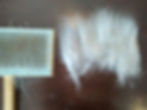A Yarn is Born
My blog has been quiet in recent months, because there haven't been many new events to share. It's been winter, which is a slow time on the farm. Of course, I have to tend the animals, but that's hardly a full-time job, especially when I hurry through my barn chores so I can return to my warm house. Fortunately, I live on a FIBER FARM, and winter is perhaps the BEST time for one of the essential tasks: I've been spinning. There's nothing cozier than to sit indoors on a blustery, snowy day, and make yarn. It's time that I show how I do it.
This yarn is going to be Forsythia Fifty, a fifty-gram skein of a 50/50 blend of angora and alpaca. It will be 2-ply, so I need 25 grams of fiber for each ply. I'm actually going to weigh out MORE than 25 grams, to allow for some waste; some of the fibers are matted (tangled) or too short ("second cuts"), and can't be used. There also is dirt (alpacas like dust baths), "VM" (vegetable matter, such as hay or seed heads from the pasture), and "tags" (manure that gets tangled in the fleece), all of which will fall out during processing, or will wash out at the end.
Here's a compressed bag of fiber to make one ply:

and that same fiber, when it's let out of the bag (pencil added to provide size reference):

I'm using light fawn alpaca fiber from Yuri and black angora fiber from Gallagher and Murphy. I normally wouldn't blend tan and gray colors, but I'm planning to dye this skein, so I think it will look fine when it's finished.
I want the two different fibers to be fairly evenly distributed throughout the yarn, so I'll divide my piles of fluff into smaller lots and match them up:

Now to prepare the fiber for spinning. I use hardcards to open up the locks of fiber, blend the two fibers together, and straighten the little hairs so they're more-or-less parallel. I'll start by "dressing" a card with a small amount of fiber,

then I'll brush the other card over it lightly several times

until the fibers are fairly straight.

I'll peel the batt off the card,


roll it up,

and gently tease it out into a long piece of roving.

Then repeat, until all the fiber has been carded. My pile of rovings is so much fluffier than that little plastic bag I started with!

Now it's time to start spinning. I use an Ashford Joy wheel. Like all spinning wheels, it serves two functions: As I treadle to keep the wheel spinning, it twists the fibers into yarn, and it also wraps the spun yarn around the bobbin. I draft some fibers out of the roving, and let the wheel do the rest of the work.

Whew! I finally used all that roving I prepped, but I'm less than half done making this skein. The "singles" thread I just spun is full of potential energy; if I remove the tension and let a length of it hang loose, the thread twists around itself and makes a snarled mess. Some crafters do like working with singles yarns, but I prefer a balanced yarn.

So I'll spin another bobbin of singles,

and I'll ply them together, by running them both through the wheel while it's spinning the opposite direction from before. The two yarns will then twist around each other.

Because I'm working with yarns that have already been spun, and not with a lot of loose fluff, I can work outdoors even when there's a breeze. Ah! I love that spring sunshine! I do, though, have to pause frequently and check my plying twist; if a loose loop of plied yarn twists onto itself, I take note of which direction it's twisting and make the appropriate adjustments in my plying.

At last! A finished bobbin of balanced, 2-ply yarn:

Keeping yarn stored tightly wound on a bobbin can stretch the yarn, so I want to wrap mine into a skein. I wrap it around my improvised PVC niddy-noddy and tie it in a few spots.

When I take it off the niddy-noddy, I have a big loop, which I can twist into a skein. Not yet, though--I want to dye this one first. I'll set it aside until I have enough for a batch of dye.

Tune in later for Part II: A Yarn is Dyed.




















